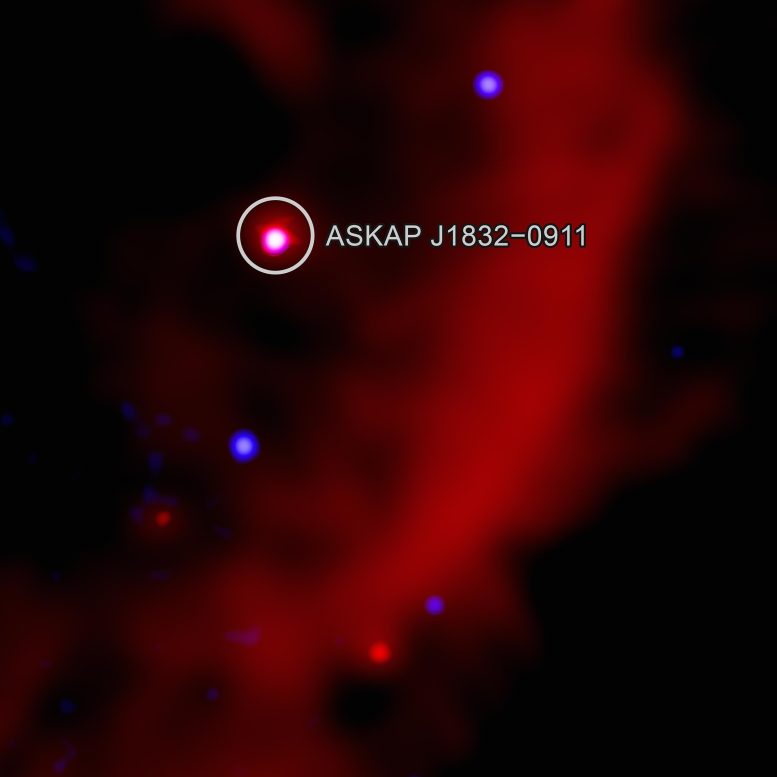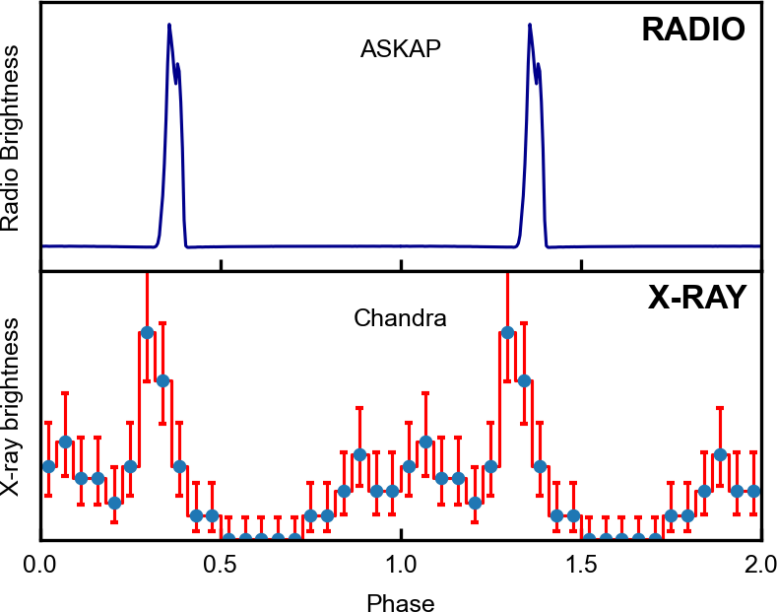
ASKAP J1832 pulses every 44 minutes in both radio and X-rays—something never seen before—hinting at an entirely new type of star or system.
- ASKAP J1832 is part of a rare group of space objects that pulse in radio waves every few dozen minutes.
- What makes it stand out is that it also pulses in X-rays, as detected by NASA’s powerful Chandra X-ray Observatory.
- This marks the first time scientists have seen X-ray signals from one of these “long period radio transients.”
- Experts are still unraveling the mystery. It could be a super-magnetic neutron star—or possibly a white dwarf with unusual properties.
Unveiling a One-of-a-Kind Cosmic Mystery
Scientists have found a star that’s breaking all the rules—and it might belong to a brand-new class of mysterious cosmic objects.
By combining observations from NASA’s powerful Chandra X-ray Observatory and Australia’s ASKAP radio telescope on Wajarri Country, astronomers zeroed in on an object named ASKAP J1832−0911 (or simply ASKAP J1832). What they found was unlike anything seen before.
ASKAP J1832 is part of a rare group of space objects called “long period radio transients,” first discovered in 2022. These objects emit repeating bursts of radio waves, but much more slowly than the rapid-fire pulses seen in traditional pulsars. Instead of flashing multiple times per second, ASKAP J1832 pulses every 44 minutes—a rhythm that puts it in a category of its own.

First X-Ray Signal Detected in Its Kind
What makes ASKAP J1832 even more remarkable is that it’s not just pulsing in radio waves. NASA’s Chandra Observatory revealed that it also emits X-rays on the exact same 44-minute cycle. This is the first time X-ray signals have ever been found from this kind of object.
In a striking composite image (above), the team combined X-rays from Chandra (blue), infrared from NASA’s Spitzer Space Telescope (in shades of cyan and orange), and radio data from LOFAR (in red) to create a vivid portrait of this stellar enigma. A close-up (below) zooms in on the source, showing the precise region where these signals originate.
Even more puzzling, ASKAP J1832’s emissions faded dramatically over six months—in both radio and X-ray wavelengths. This strange mix of short-term pulses and long-term changes is unlike anything ever observed in our Milky Way galaxy, leaving scientists with more questions than answers.

Breaking the Mold of Known Stellar Objects
The research team argues that ASKAP J1832 is unlikely to be a pulsar or a neutron star pulling material from a companion star because its properties do not match the typical intensities of radio and X-ray signals of those objects. Some of ASKAP J1832’s properties could be explained by a neutron star with an extremely strong magnetic field, called a magnetar, with an age of more than half a million years. However, other features of ASKAP J1832 — such as its bright and variable radio emission — are difficult to explain for such a relatively old magnetar.
Clues from a Nearby Supernova Remnant
On the sky, ASKAP J1832 appears to lie within a supernova remnant, the remains of an exploded star, which often contain a neutron star formed by the supernova. However, the research team determined that the proximity is probably a coincidence and two are not associated with each other, encouraging them to consider the possibility that ASKAP J1832 does not contain a neutron star. They concluded that an isolated white dwarf does not explain the data but that a white dwarf star with a companion star might. However, it would require the strongest magnetic field ever known for a white dwarf in our galaxy.
A paper by Ziteng Wang (Curtin University in Australia) and collaborators describing these results appears in the journal Nature. Another team independently discovered this source using the DAocheng Radio Telescope and submitted their paper to the arXiv on the same day as the team led by Dr. Wang. They did not report the X-ray behavior described here.

Reference: “Detection of X-ray emission from a bright long-period radio transient” by Ziteng Wang, Nanda Rea, Tong Bao, David L. Kaplan, Emil Lenc, Zorawar Wadiasingh, Jeremy Hare, Andrew Zic, Akash Anumarlapudi, Apurba Bera, Paz Beniamini, A. J. Cooper, Tracy E. Clarke, Adam T. Deller, J. R. Dawson, Marcin Glowacki, Natasha Hurley-Walker, S. J. McSweeney, Emil J. Polisensky, Wendy M. Peters, George Younes, Keith W. Bannister, Manisha Caleb, Kristen C. Dage, Clancy W. James, Mansi M. Kasliwal, Viraj Karambelkar, Marcus E. Lower, Kaya Mori, Stella Koch Ocker, Miguel Pérez-Torres, Hao Qiu, Kovi Rose, Ryan M. Shannon, Rhianna Taub, Fayin Wang, Yuanming Wang, Zhenyin Zhao, N. D. Ramesh Bhat, Dougal Dobie, Laura N. Driessen, Tara Murphy, Akhil Jaini, Xinping Deng, Joscha N. Jahns-Schindler, Y. W. Joshua Lee, Joshua Pritchard, John Tuthill and Nithyanandan Thyagarajan, 28 May 2025, Nature.
DOI: 10.1038/s41586-025-09077-w
Launched by NASA in 1999, the Chandra X-ray Observatory is one of the world’s most powerful tools for observing the universe in high-energy X-rays. Designed to detect emissions from extremely hot regions of space—such as the remnants of exploded stars, black holes, and neutron stars—Chandra has played a critical role in advancing our understanding of cosmic phenomena.
The observatory is managed by NASA’s Marshall Space Flight Center in Huntsville, Alabama, while science operations are conducted by the Chandra X-ray Center, which is operated by the Smithsonian Astrophysical Observatory from Cambridge, Massachusetts. Meanwhile, flight operations are overseen from Burlington, Massachusetts.
Chandra’s unmatched X-ray vision continues to uncover some of the universe’s most energetic and mysterious events, making it a cornerstone of NASA’s Great Observatories program.
Never miss a breakthrough: Join the SciTechDaily newsletter.
4 Comments
How many planets have we discovered?
5903 exoplanets outside the solar system – this according to an internet search.
Plus add the planets in the solar system.
Likely a white dwarf or very old neutron star in a tight trinary system. If the interaction with the third nearly dead star every rotation causes these energetic bursts, and said star is in an elliptical orbit, then variations in intensity would be expected as it drew further away or nearer. The period, determined by the orbit of the white dwarf/neutron star would not change.
This will be retracted soon or turn out to be another hoax. Stories like this are like the boy who cried wolf, and eventually people ignore them as they should, It will be no different with this “story.”